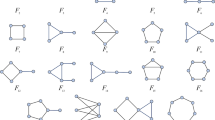Abstract
In this paper, we present the outer product decomposition of a product of compatible linked networks. It provides a foundation for the fractional approach in network analysis. We discuss the standard and Newman’s normalization of networks. We propose some alternatives for fractional bibliographic coupling measures.


Similar content being viewed by others
References
Batagelj, V. (2007). WoS2Pajek. Networks from web of science. Version 1.5 (2017). http://vladowiki.fmf.uni-lj.si/doku.php?id=pajek:wos2pajek.
Batagelj, V. (2018). Github: biblio—Bibliographic network analysis. https://github.com/bavla/biblio.
Batagelj, V., & Cerinšek, M. (2013). On bibliographic networks. Scientometrics, 96(3), 845–864.
Batagelj, V., Doreian, P., Ferligoj, A., & Kejžar, N. (2014). Understanding large temporal networks and spatial networks: Exploration, pattern searching, visualization and network evolution. Chichester: Wiley.
Carley, K. M. (2003). Dynamic network analysis. In R. Breiger & K. M. Carley (Eds.), Summary of the NRC workshop on social network modeling and analysis (pp. 133–145). Washington, DC: National Research Council.
Cerinšek, M., & Batagelj, V. (2015). Network analysis of Zentralblatt MATH data. Scientometrics, 102(1), 977–1001.
Cerinšek, M., & Batagelj, V. (2017). Semirings and matrix analysis of networks. In R. Alhajj & J. Rokne (Eds.), Encyclopedia of social network analysis and mining. New York: Springer.
Clarivate Analytics (2018). https://clarivate.com/products/web-of-science/databases/.
De Nooy, W., Mrvar, A., & Batagelj, V. (2018). Exploratory social network analysis with Pajek: Revised and expanded edition for updated software., Structural analysis in the social sciences Cambridge: Cambridge University Press.
Diesner, J., & Carley, K. M. (2004). Revealing social structure from texts: Meta-matrix text analysis as a novel method for network text analysis, Chapter 4. In V. K. Narayanan & D. J. Armstrong (Eds.), Causal mapping for research in information technology (pp. 81–108). Calgary: Idea Group Inc.
Gauffriau, M. (2017). A categorization of arguments for counting methods for publication and citation indicators. Journal of Informetrics, 11(3), 672–684.
Kessler, M. (1963). Bibliographic coupling between scientific papers. American Documentation, 14(1), 10–25.
Krackhardt, D., & Carley, K. M. (1998). A PCANS model of structure in organization. In Proceedings of the 1998 international symposium on command and control research and technology evidence based research (pp. 113–119), Vienna, VA.
Leydesdorff, L., & Park, H. W. (2016). Full and fractional counting in bibliometric networks. Journal of Informetrics, 11(1), 117–120.
Lindsey, D. (1980). Production and citation measures in the sociology of science: The problem of multiple authorship. Social Studies of Science, 10(2), 145–162.
Marshakova, I. (1973). System of documentation connections based on references (sci). Nauchno-Tekhnicheskaya Informatsiya Seriya, 2(6), 3–8.
Newman, M. E. J. (2001). Scientific collaboration networks. II. Shortest paths, weighted networks, and centrality. Physical Review E, 64(1), 016132.
Newman, M. E. J. (2004). Coauthorship networks and patterns of scientific collaboration. In Proceedings of the national academy of sciences of the United States of America (vol. 101, no. Suppl1, pp. 5200–5205).
Perianes-Rodriguez, A., Waltman, L., & Van Eck, N. J. (2016). Constructing bibliometric networks: A comparison between full and fractional counting. Journal of Informetrics, 10(4), 1178–1195.
Prathap, G., & Mukherjee, S. (2016). A conservation rule for constructing bibliometric network matrices. arXiv:1611.08592
Small, H. (1973). Co-citation in the scientific literature: A new measure of the relationship between two documents. Journal of the American Society for Information Science, 24(4), 265–269.
Acknowledgements
The paper is based on presentations on 1274. Sredin seminar, IMFM, Ljubljana, 29. March 2017; NetGloW 2018, St Petersburg, July 4-6, 2018; and COMPSTAT 2018, Iasi, Romania, August 28-31, 2018. This work is supported in part by the Slovenian Research Agency (research program P1-0294 and research projects J1-9187, J7-8279 and BI-US/17-18-045) (Javna Agencija za Raziskovalno Dejavnost RS), project CRoNoS (COST Action IC1408) (European Cooperation in Science and Technology) and by Russian Academic Excellence Project ‘5-100’.
Author information
Authors and Affiliations
Corresponding author
Rights and permissions
About this article
Cite this article
Batagelj, V. On fractional approach to analysis of linked networks. Scientometrics 123, 621–633 (2020). https://doi.org/10.1007/s11192-020-03383-y
Received:
Published:
Issue Date:
DOI: https://doi.org/10.1007/s11192-020-03383-y
Keywords
- Social network analysis
- Linked networks
- Bibliographic networks
- Network multiplication
- Fractional approach
- Newman’s normalization
- Bibliographic coupling




